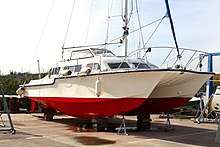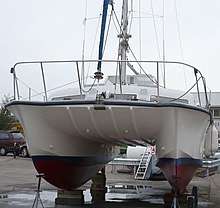Catalac catamarans
Catalac is a defunct English maritime construction company that specialised in building sailing catamarans. The company was founded by Tom Lack (hence "Cata + Lac"), in Christchurch, Dorset.[1] After a successful period of production, the company closed in 1986. In the 1990s, the Catalac 9M was briefly revived and updated in the US as the "Catalac 900".
| Limited Company | |
| Founded | 1976 |
| Founder | Tom Lack |
| Headquarters | , England |
| Products | Catamarans |
| Website | catamaransite |
Catalac catamarans


The Catalac company's main model was the 9-metre 9M. All the other models are derived from the 9M and use a similar design concept; the 8M even used the same hulls as the 9M.[2] All Catalacs were very strongly-built with thick grp hulls and glass windows. Some of the superstructure, such as the solid foredeck, was of sandwich grp construction. Compared to modern designs, Catalacs had a narrow beam of less than half the LOA,[3] and vertical transoms (rather than the more modern "sugar scoop" with transom steps). Initially featuring lifting dinghy-type rudders, Catalac moved to fixed rudders protected by a skeg; this allowed the boats to sail a little closer to the wind. Only the 9M has a staggered sheerline (which allows easy aft access from a pontoon); the other models all have an unbroken sheerline.
The sailplan is a masthead Bermuda sloop of modest area. Although modern catamarans tend to have a fractional rig, the Catalac's mainsail has a straight leech, short battens and no roach. Twin backstays run to the transoms, enabling the forestay to be kept taut. The babystay gives a slight mast bend to enable a fuller-shaped mainsail. There are no known examples of a Catalac ever pitchpoling or being blown over and upturned.[4]
All Catalac catamarans feature:[5]
- Widely-flaring chines and overhanging bows.
- A considerable "rocker" underwater profile to allow manoeuvrability and skidding to leeward under high winds.
- Solid foredeck with no trampoline.
- Twin inboard diesels (sited aft), or single centrally-placed steered outboard.
- Vertical transoms.
- Aft cockpit with protected wheel steering.
- Conventional accommodation, with two main berths on the bridgedeck forward of the saloon.
- Occasional single berths further aft in the hulls.
- Galley-below layout (in the port or starboard hull).
- Single head & shower room.
- Roller furling on the forestay.
Reception
Catalacs have been very well-received. In Cruising in Catamarans[6] Charles Kanter declared that the Catalac "27 and 30 are among the best cruising catamarans ever produced". Kanter wrote,"when sailing in a 41-foot Catalac 12M alongside a beautiful 55 foot gold-plate ketch, Pacific High, we loped along with a steady upright forward motion and in 3 hours they were hull down over the horizon. In 16 hours we had covered 140-odd miles". In Catamarans for Cruising,[7] Jim Andrews (himself a Catalac owner) praises the 9M's interior layout and its good sea-keeping qualities. A Practical Boat Owner magazine review of a Catalac 9M summarised it as a "competent, versatile and long-lasting cat".[8]
Overall, 255 Catalac 9M boats were made, making it the most successful model in the range. The other production figures are: 8M - 216 built; 10M - 45 built; 11M - (no data); 12M - 27 built.
Catalac models
Catalac 8M (aka 27)[9]
- LOA: 27"
- LWL: 25' 4"
- Beam: 13' 8"
- Draft: 2' 4"
- Displacement: 6,000 lbs (dry)
- Sail area: Main xx sq ft, Jib 348 sq ft
Catalac 9M (aka 30)[10]
- LOA: 29' 3"
- LWL: 25' 4"
- Beam: 13' 9"
- Draft: 2' 6"
- Displacement: 8,000 lbs (dry)
- Sail area: Main xx sq ft, Jib 348 sq ft
Catalac 10M (aka 34)[11]
- LOA: 33' 8"
- LWL: 27'
- Beam: 15' 3"
- Draft: 2' 9"
- Displacement: 11,000 lbs (dry)
- Sail area: Main 283 sq ft, Genoa 333 sq ft
Catalac 11M (aka 36)[12]
- LOA: 35' 9"
- LWL: 28' 3"
- Beam: 15' 5"
- Draft: 2' 9"
- Displacement: 13,000 lbs (dry)
- Sail area: Main 27fsq.ft; Genoa 333 sq.ft
Catalac 12M (aka 41)[13]
- LOA: 40' 10"
- LWL:36' (est)
- Beam: 17' 6"
- Draft: 3' 1"
- Displacement: 18,500 lbs (dry)
- Sail area: Main: 336 sq ft, Genoa 410 sq ft
See also
References
- Catalac website
- The 8M had the same LWL as the 9M, but was 2' 3" shorter; the LOA difference being that (unlike the 8M) the 9M has a platform aft of the cockpit and transoms.
- The 9M's beam is 0.466 of its LOA.
- The designer Tom Lack even offered a reward if any sailor managed to "fly" the weather hull; Lack kept his money!
- Source Catamaran site
-
- Kanter, Charles E. (2002). Cruising in Catamarans. Kanter. ISBN 9 780961 840662.
-
- Andrews, Jim (1974). Cruising in Catamarans. Hollis & Carter. ISBN 0 37010339 4.
- PBO magazine review of 9M
- 8M data
- 9M data
- 10M data
- 11M data
- 12M data